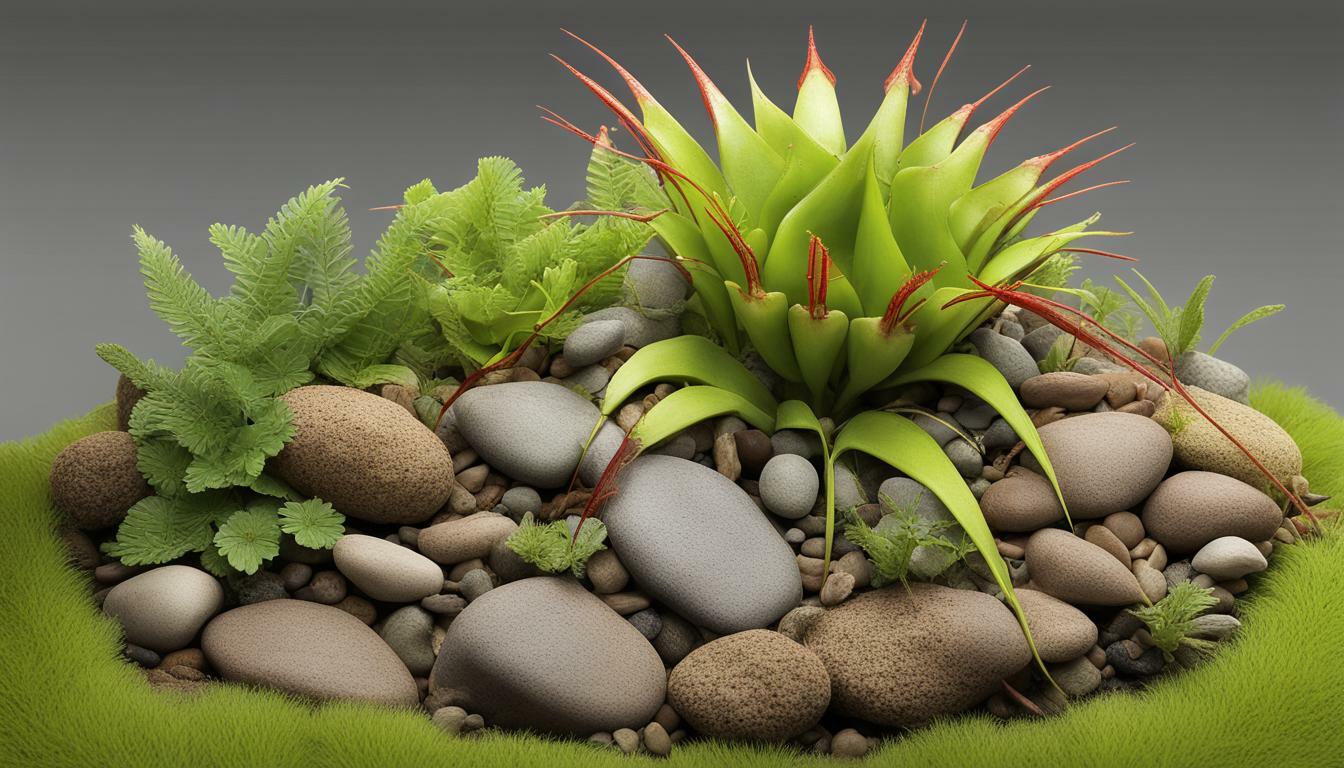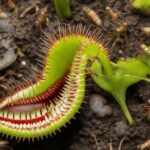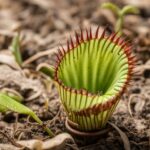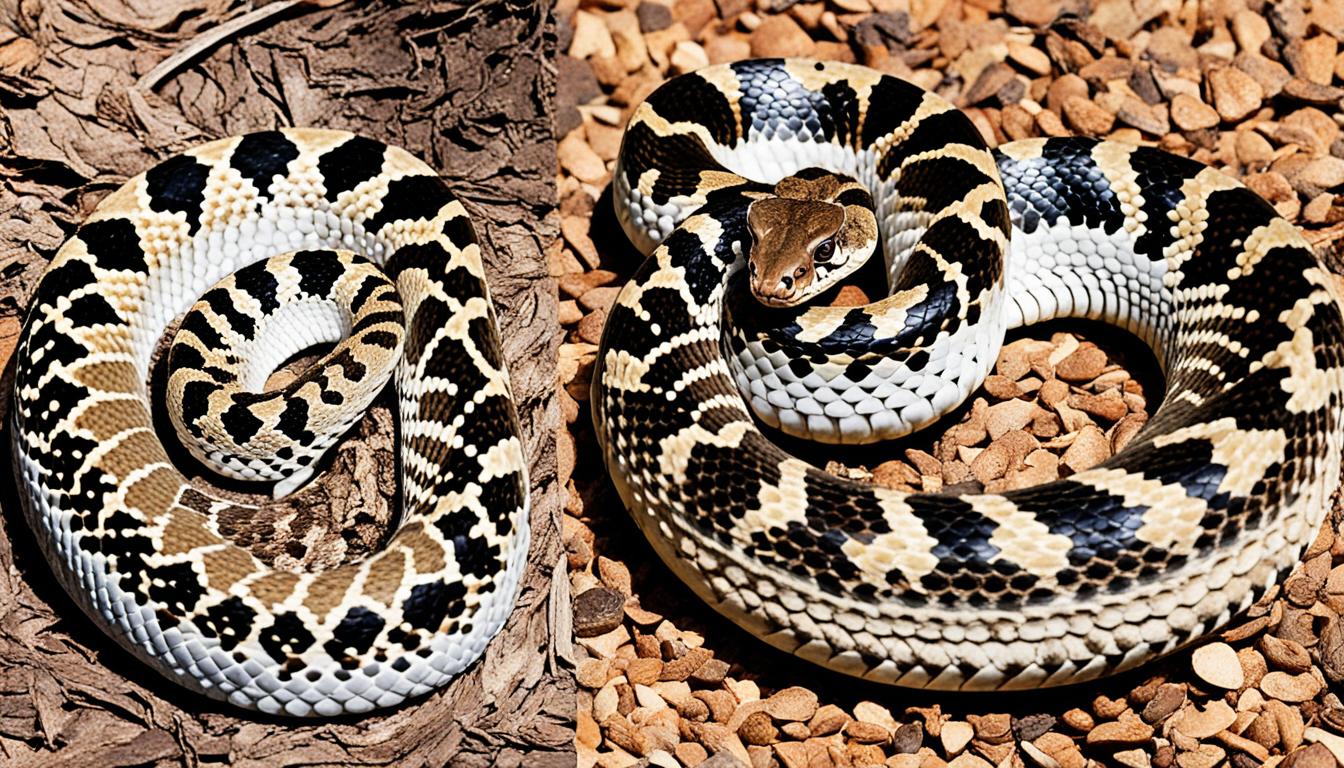If you’re a Venus Flytrap owner or a plant enthusiast, you know that keeping these carnivorous plants healthy and free from pests is crucial. Venus Flytraps are unique, and their traps attract insects that are essential for their survival. However, they also attract pests that can damage the plant’s health and affect its growth.
So, how do you prevent pests from attacking Venus Flytraps? In this article, we’ll share some effective tips and techniques for Venus Flytrap pest prevention and management.
Key Takeaways:
- Effective pest prevention is crucial for the health and growth of Venus Flytraps.
- Common pests that attack Venus Flytraps include spider mites, aphids, and mealybugs.
- Signs of pest infestation include black spots, stunted growth, and distorted traps.
- Natural methods like neem oil and insecticidal soap can be used to prevent and control pests.
- Effective pest control measures include manual removal, chemical pesticides, and sticky traps.
- Maintaining a healthy environment with proper watering and sunlight is also essential for Venus Flytrap care.
Understanding Common Pests that Attack Venus Flytraps
Venus Flytraps are fascinating carnivorous plants that are native to the southeastern United States. They have evolved to capture insects and other small creatures as a source of nutrients, but unfortunately, they can also fall victim to pests that can damage their delicate foliage. Knowing the common pests that can attack your Venus Flytrap is the first step in preventing and managing pest infestations.
There are several types of insects and other creatures that are harmful to Venus Flytraps. Here are some of the most common:
| Pest | Description |
|---|---|
| Aphids | Small, soft-bodied insects that feed on plant sap and excrete a sticky substance that can attract other pests and promote fungal growth. |
| Spider Mites | Tiny arachnids that feed on plant fluids and can leave behind webbing and stippling on the leaves and stems of Venus Flytraps. |
| Fungus Gnats | Small flies that lay eggs in wet soil or potting mix. The larvae feed on plant roots, and the adults can be a nuisance by flying around the plant and laying more eggs. |
| Slugs and Snails | These mollusks can damage the leaves and roots of Venus Flytraps by feeding on them. They also leave behind a slimy trail that can attract other pests and promote fungal growth. |
It’s important to note that Venus Flytraps can also be host to other small creatures, such as ants, spiders, and beetles. While these animals are not necessarily harmful to the plant, they can attract other pests or create an environment that is not conducive to the Venus Flytrap’s growth.
By understanding the common pests that attack Venus Flytraps, you can take steps to prevent and manage infestations. In the next section, we’ll discuss how to identify the signs of pest infestation on your Venus Flytrap.
Identifying Signs of Pest Infestation on Venus Flytraps
Venus Flytraps are susceptible to a variety of pests that can cause significant damage to the plant if left unchecked. Knowing the signs of pest infestation is crucial to prevent such damage and keep your Venus Flytrap healthy.
The first indication of pest infestation is the presence of insects on the plant. Look for creatures such as mites, aphids, and ants crawling on the leaves, or in the soil surrounding the plant. Another sign is the appearance of small holes in the leaves. Both of these symptoms are usually indicative of an infestation.
If your Venus Flytrap starts to look unhealthy, despite proper care, it could also be a sign of pest damage. Check for yellowing or browning of the leaves, wilting, and stunted growth. These symptoms could indicate the presence of pests that are damaging the plant’s root system, preventing it from taking up water and nutrients.
It’s important to act quickly if you suspect a pest infestation on your Venus Flytrap. The longer you wait, the more damage the pests can do, and it becomes increasingly difficult to save the plant.
To detect pests on your Venus Flytrap, examine the plant thoroughly, using a magnifying glass if necessary. Look for signs of any insects, damage, or abnormalities. You can also run your finger over the leaves’ surface, feeling for any sticky or slimy substance that could indicate the presence of pests, such as scale insects.
Natural Methods to Protect Venus Flytraps from Pests
Venus Flytraps are delicate plants that require special care and attention to thrive. One of the biggest threats to their health and survival are pest infestations. Fortunately, there are natural methods you can use to protect your Venus Flytraps from pests without harming the environment or risking the health of your plant.
Organic pest control for Venus Flytraps: One of the most effective ways to keep pests away from your Venus Flytraps is by using organic pest control methods. This involves using natural substances such as neem oil, garlic, and vinegar to create homemade sprays that repel insects and other pests. You can also use beneficial insects such as ladybugs and praying mantises to eat the pests that may be attacking your Venus Flytraps.
Eco-friendly Venus Flytrap pest prevention: Another way to protect your Venus Flytraps from pests is by using eco-friendly pest prevention methods. This involves creating an environment that is less attractive to pests by removing their food sources and breeding grounds. For example, you can keep your Venus Flytraps clean and free of debris, and avoid overwatering or over-fertilizing them, as this can create the perfect breeding ground for pests.
Other natural pest control methods: There are several other natural methods you can use to protect your Venus Flytraps from pests, such as using sticky traps, diatomaceous earth, and companion planting. Sticky traps are essentially pieces of paper coated with a sticky substance that attracts and traps insects. Diatomaceous earth is a natural substance that is made from the fossilized remains of tiny aquatic organisms. It works by causing insects to dehydrate and die. Companion planting involves planting other species of plants that have natural pest-repelling properties next to your Venus Flytraps.
Implementing Effective Pest Control Measures for Venus Flytraps
Once you have identified the pests attacking your Venus Flytrap, it’s time to take action to protect your plant. There are many effective pest control measures that you can implement to effectively manage the problem. Here are some tips to get you started:
Diatomaceous Earth
Diatomaceous earth is a natural, non-toxic way to control pests on Venus Flytraps. It works by breaking down the exoskeletons of insects, causing them to dehydrate and die. Simply sprinkle diatomaceous earth around the base of your Venus Flytrap to create a barrier that pests cannot cross. Be sure to reapply after rain or watering.
Insecticidal Soap
Insecticidal soap is a safe and effective way to control pests on Venus Flytraps. It works by suffocating and drying out insects on contact. Dilute the soap according to the instructions on the label and spray on the affected areas of your Venus Flytrap. Repeat every 7-10 days until the pests are gone.
Neem Oil
Neem oil is a natural pesticide that can be used to control pests on Venus Flytraps. It works by disrupting the life cycle of insects and preventing them from feeding and breeding. Mix neem oil with water and spray on the affected areas of your Venus Flytrap. Repeat every 7-10 days until the pests are gone.
Sticky Traps
Sticky traps are another effective way to control pests on Venus Flytraps. They work by capturing insects on a sticky surface and preventing them from moving around. Simply place sticky traps around the base of your Venus Flytrap to catch any crawling insects. Be sure to check and replace the traps regularly.
Keep Your Venus Flytrap Clean
Keeping your Venus Flytrap clean is an important part of preventing pest infestations. Remove any dead leaves or insects from the plant and clean the soil regularly. This will help to reduce the risk of pests and keep your plant healthy.
By implementing these effective pest control measures, you can keep your Venus Flytrap healthy and pest-free. Remember to monitor your plant regularly and take action at the first sign of a pest infestation.
Maintaining a Healthy Environment for Venus Flytraps
If you want your Venus Flytrap to thrive, it’s essential to provide the optimal conditions for its growth. Here are some essential care tips for maintaining a healthy environment for your Venus Flytraps:
Lighting
Venus Flytraps require plenty of sunlight to grow and thrive. Place your Venus Flytrap in a spot where it can receive at least four hours of direct sunlight every day. If you’re growing your Venus Flytrap indoors, place it near a sunny window or use artificial grow lights to provide adequate lighting.
Watering
Venus Flytraps require moist soil to grow, but they don’t like sitting in standing water. Use a well-draining soil mix and water your Venus Flytrap regularly, keeping the soil consistently moist. Avoid using tap water, which can contain minerals that are harmful to Venus Flytraps. Instead, use distilled water or rainwater to water your plant.
Humidity
Venus Flytraps thrive in high humidity environments. To increase humidity levels around your plant, place a tray of water near the plant or use a humidifier. Avoid placing your Venus Flytrap near sources of dry air, such as vents or heaters.
Temperature
Venus Flytraps prefer temperatures between 70-80°F during the day and 50-60°F at night. Try to keep your plant away from drafts, such as open windows or doors.
Fertilizer
While Venus Flytraps can derive their nutrients from insects, you can use a weak fertilizer solution to supplement their diet once every few months. Use a fertilizer that is low in minerals and free of urea, ammonium, and phosphorus.
By following these care tips, you can help your Venus Flytrap thrive and prevent pest attacks. Remember to keep a watchful eye on your plant for signs of pest infestation and take action immediately if you spot any problems.
Tips on How Do You Prevent Pests from Attacking Venus Flytraps
Pests can cause significant damage to Venus Flytraps, which rely on insects as their primary source of nutrients. As a Venus Flytrap enthusiast, it’s essential to be proactive in preventing pests from attacking your plants. Here are some tips to help you keep your Venus Flytraps pest-free:
Understanding Common Pests that Attack Venus Flytraps
Knowing the common pests that attack Venus Flytraps is crucial in preventing pest infestation. Some of the most common insects that can damage Venus Flytraps include aphids, spider mites, and fungus gnats. These pests can cause stunted growth, leaf drop, and overall decline in plant health.
Identifying Signs of Pest Infestation on Venus Flytraps
It’s essential to inspect your Venus Flytraps regularly to detect any signs of pest infestation. Look out for wilting leaves, yellowing or browning foliage, and insect activity on and around the plant. Spider webs on the plant can indicate the presence of spider mites, while sticky traps can catch fungus gnats.
Natural Methods to Protect Venus Flytraps from Pests
Several natural methods can be used to protect Venus Flytraps from pests. Sticky traps, made of bright yellow paper, can be placed around the plant to trap flying insects. Introducing beneficial insects, such as ladybugs, can also help control pests. Additionally, spraying the plant with a mixture of water and neem oil can deter insects.
Implementing Effective Pest Control Measures for Venus Flytraps
If your Venus Flytraps are severely infested with pests, you may need to implement more effective pest control measures. Insecticidal soaps and oils can be used to control pests, but it’s essential to use them sparingly to avoid harming the plant. You can also use sticky barriers or apply diatomaceous earth around the plant to prevent insects from crawling onto it.
Maintaining a Healthy Environment for Venus Flytraps
Maintaining a healthy environment for your Venus Flytraps is essential for pest prevention. Venus Flytraps require bright, indirect sunlight and well-draining soil that is kept consistently moist. Avoid over-fertilizing the plant, as this can attract pests. Keep the plant’s surroundings clean, free of debris and dead insects, and provide a humid environment.
Conclusion
Preventing pest attacks on your Venus Flytraps is crucial in ensuring the plant’s health and longevity. Regular inspection, natural pest control methods, and maintaining a healthy environment can help you keep your plants pest-free. By following these tips, you can enjoy the beauty and unique characteristics of your Venus Flytraps without worrying about pest infestation.
How Can I Keep My Venus Flytrap Alive and Pest-Free?
To keep a venus flytrap alive and pest-free, provide proper care and environment. Avoid using fertilizers or tap water, as they are harmful to these plants. Instead, use distilled water or rainwater. Place the plant in a sunny area, but avoid exposing it to scorching temperatures. Maintain a humid atmosphere by placing the pot on a tray filled with water or using a humidifier. Lastly, keep indoor pests at bay by inspecting the plant regularly and manually removing any bugs.
FAQ
Q: How do you prevent pests from attacking Venus Flytraps?
A: There are several natural methods you can use to protect Venus Flytraps from pests. Some options include regularly inspecting the plants for signs of infestation, using insect-repelling plants nearby, and maintaining a healthy environment for the plants to thrive.
Q: What are some common pests that attack Venus Flytraps?
A: Common pests that pose a threat to Venus Flytraps include aphids, spider mites, fungus gnats, and slugs. These insects can cause damage to the plant and inhibit its growth if left untreated.
Q: How can I identify signs of pest infestation on my Venus Flytraps?
A: Signs of pest infestation on Venus Flytraps may include wilting or discolored leaves, small holes or bite marks on the leaves, an increase in insect activity around the plant, or the presence of sticky residue on the leaves.
Q: Are there natural methods to protect Venus Flytraps from pests?
A: Yes, there are natural methods you can use to protect Venus Flytraps from pests. These include introducing beneficial insects that prey on pests, using neem oil or insecticidal soap sprays, and creating a barrier around the plants using diatomaceous earth or copper tape.
Q: What are some effective pest control measures for Venus Flytraps?
A: Effective pest control measures for Venus Flytraps include manually removing pests from the plants using tweezers or a mild insecticide solution, placing sticky traps near the plants to catch flying insects, and regularly cleaning the surrounding area to minimize pest habitats.
Q: How can I maintain a healthy environment for Venus Flytraps?
A: To maintain a healthy environment for Venus Flytraps, make sure they receive adequate sunlight and are planted in well-draining soil. Avoid overwatering the plants and provide a humid environment by placing the pots on a tray filled with water and pebbles. Additionally, remove any dead or decaying plant matter from around the plants to prevent pest infestation.











